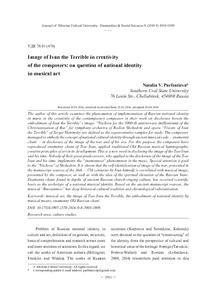Image of Ivan the Terrible in creativity of the composers: on question of national identity in musical art
Скачать файл:
URI (для ссылок/цитирований):
https://elib.sfu-kras.ru/handle/2311/20541Автор:
Parfentieva, Natalia V.
Парфентьева, Н.В.
Дата:
2016-08Аннотация:
The author of this article examines the phenomenon of implementation of Russian national identity in music in the creativity of the contemporary composers in their work on disclosure herein the embodiment of Ivan the Terrible’ s image. “Stichera for the 1000-th anniversary (millennium) of the Christianization of Rus” for symphony orchestra of Rodion Shchedrin and opera “Visions of Ivan the Terrible” of Sergei Slonimsky are defined as the representative samples for study. The composers managed to embody the concept of national cultural identity through ancient musical code – znamenny chant – in disclosure of the image of the tsar and of his era. For this purpose the composers have reproduced znamenny chant of Tsar Ivan, applied traditional Old Russian musical hymnographic creative principles of art in its development. This is a new word in disclosing the image of the Tsar Ivan and his time. Nobody of their great predecessors, who applied to the disclosure of the image of the Tsar Ivan and his time, implements the “znamennost” phenomenon in the music. Special attention is paid to the “Stichera” of Shchedrin. It is shown that the self-identification of image of the tsar, presented in the manuscript sources of the 16th – 17th centuries by Ivan himself, is correlated with musical image, presented by the composer, as well as with the idea of the spiritual elevation of the Russian State. Znamenny chant, found in depths of ancient Russian church-singing culture, has received scientific basis as the archetype of a national musical identity. Based on the ancient manuscript sources, the musical “Russianness” has deep historical cultural tradition and chronological substantiation В статье исследуется феномен воплощения русской национальной идентичности в музыкальном искусстве на примере творчества выдающихся современных композиторов при обращении их к образу царя Ивана Грозного. В качестве репрезентативных источников исследования представлены «Стихира на 1000-летие Крещения Руси» Р. Щедрина и опера С. Слонимского «Видения Иоанна Грозного». В обоих произведениях проступает звучание древнерусского знаменного распева. Композиторы, стремясь воспроизвести распев самого царя Ивана, применили древнерусские принципы в его развитии. Им удалось воплотить в раскрытии образа царя и его эпохи концепт национально-культурной идентичности через древний музыкальный код – «знаменность». Это новое слово в воплощении образа Грозного, так как ни один из великих предшественников, обращавшихся к раскрытию образа царя музыкальными средствами, феномен знаменности не претворял. Особое внимание в статье уделяется «Стихире» Р. Щедрина. Показано, что самоидентификация образа Грозного, представленная в рукописных источниках XVI-XVII вв., коррелирует с музыкальным образом, представленным композитором, а также с идеей духовного возвышения Отечества. Найденный в глубинах древнерусской церковно-певческой культуры знаменный распев получает научное обоснование как архетип национальной музыкальной идентичности. Основанная на древних рукописных источниках, музыкальная «русскость» имеет глубину историко-культурной традиции, ее хронологическое обоснование
Коллекции:
Метаданные:
Показать полную информациюСвязанные материалы
Показаны похожие ресурсы по названию, автору или тематике.
-
Musical Interests and Priorities of Vladimir Lenin (Modern Vision)
Preisman, Emil’ M.; Прейсман, Э.М. (Сибирский федеральный университет. Siberian Federal University, 2015-06)In modern Russia the problem of cultural education, including musical and aesthetic one, has become quite acute as one of the barriers on the way of globalization negative impacts. After Perestroika, the work on cultural ... -
Musical Life of Krasnoyarsk in the 60-s of the XX Century
Preisman, Emil M.; Прейсман, Э.М. (Сибирский федеральный университет. Siberian Federal University., 2016-09)The article discusses the musical life of Krasnoyarsk as the country’s art culture component. Analysis of the activities of the Krasnoyarsk Regional Philharmonic, the Theatre of Musical Comedy, the School of Art, and ... -
Музыка перед вызовами цифрового общества
Марков, Б. В.; Ярочкин, Д. А.; Markov, Boris V.; Yarochkin, Dmitriy A. (Сибирский федеральный университет. Siberian Federal University, 2021-06)В статье реконструируется ряд установок и предпосылок как создания, так и восприятия музыки, которые являются предметом когнитивно-антропологического анализа музыки. Другой теоретический мотив – необходимость различия ... -
Coloristic Properties of Piano Music Texture in Nikolai Medtner’s Works
Budnikov, Vladimir V.; Будников, В.В. (Сибирский федеральный университет. Siberian Federal University, 2016-06)This article focuses on the research of colour as applied to N. Medtner’s piano works. It discusses the composer’s views on brilliance of colour, “sonority” (звучность) of music and texture as one of its most important ... -
On the Concept of Musical Performance
Beniumov, Mikhail I.; Бенюмов, М.И. (Сибирский федеральный университет. Siberian Federal University., 2014-03)The paper focuses on the controversy term of “performance”. There was given a range of definitions of the term at different levels of commonness and specificity: performance as a kind of activity; performance as a part ...

